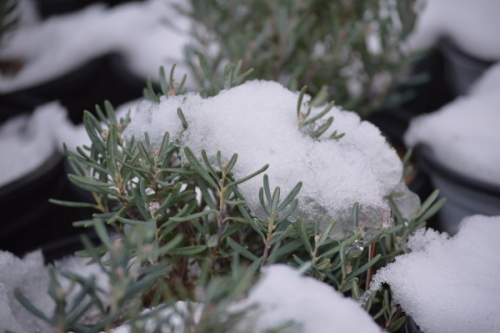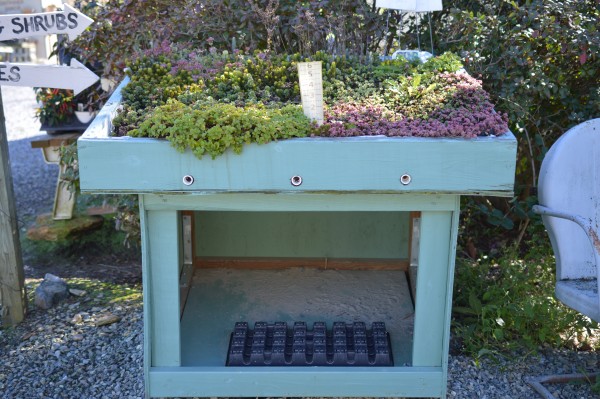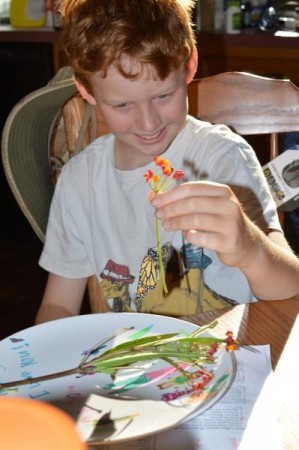
Last week’s sustained winds and forceful gusting did a whammy on most of Eastern PA and Northern Maryland. Thousands of homes and business were without power, downed trees blocked the roads, and enough shingles dislodged to keep roofers happy for the next few weeks.
Here at the farm we had lots of blowing debris but only minor damage. We did lose a greenhouse plastic covering, but were very fortunate that it was an unheated house. Neighbors had toasty greenhouses growing tiny annuals exposed which caused a mad rush to find any warm nook and cranny to shove plants into until the structure could be recovered.
What do these cold temps and high winds mean for your gardens? Thankfully, not much. Most of your perennials and even deciduous trees and shrubs are still slumbering peacefully with their food storage below ground not subject to March’s bitter gales. Even most tree and shrub buds have not swollen or broken yet, so will probably be fine.
The plants that are most susceptible to March’s temper are broad leaf evergreens and conifers. Plants like rhododendrons and azaleas and their friends are broad leaf evergreens. They continue to transpire (exchange gasses and water vapor) through tiny pores in their leaves through the winter. When the ground is frozen, the water droplets in the soil are too. This makes it difficult for plants to draw up water through their roots. Unless they have deep roots below the frost line, transpiring too much over the winter can be a problem for evergreens. Strong, sustained winds can sound a death knell for some.
To protect vulnerable young evergreens, some gardeners wrap burlap or other material around the plant to buffet the winds. You don’t want to use plastic, as this will retain too much heat and moisture. Also, be careful about trapping too many dead leaves and providing homes for small rodents that like nothing better than to gnaw the crowns and tender branches of your shrubs.
Another option is spraying the leaves with an anti-dessicant. These treatments provide an extra waxy layer to the surface of the leaf to help prevent moisture loss. In this area, these are best applied once anytime between Jan-March. Treatment too early in the fall can be counterproductive. Larger trees with well-established root systems are generally better able to maintain a moisture balance between the roots and leaves and do not require special treatment.
Don’t worry about daffodils, tulips or perennials starting to peek above the soil. They will generally halt their progress until the weather warms.
Looking around the area, despite the snow- farmers are getting ready for spring. I’ve seen several farms with plastic sheeting laid out on the ground over rows, or in large rectangles. This is for solarization. The sunlight through the clear plastic warms the soil and kills weeds underneath. Covering a bed with plastic sheeting kills weeds quickly in the summer. However, this time of year the main purpose is to warm the soil to gentle the transplant shock of young vegetable seedlings. Planting into plastic row covers can give a several week head start to produce growers.
Another common sight in Lancaster County this time of year is the steam sterilizer. It is an old-time steam-driven farm implement that forces steam into the first few inches of field soil. This kills harmful bacteria and fungal disease spores and weed seeds that would damage a crop. If you think you are hearing a train whistle, it is probably the field sterilizer.
For those of you getting sick of winter, take heart, the signs of spring are starting to appear.
Image: Bog Rosemary in the snow after we lost the greenhouse covering. KGB

 This last week I have been on a mission. Summer was full of activities with the kids, and I let part of my garden get a but…ahem…wild. A week ago as I was walking through the beautiful blooming helenium and cardinal flowers, I was aghast to see a ragweed that towered over my head. Where did that come from?! (Pictured left)
This last week I have been on a mission. Summer was full of activities with the kids, and I let part of my garden get a but…ahem…wild. A week ago as I was walking through the beautiful blooming helenium and cardinal flowers, I was aghast to see a ragweed that towered over my head. Where did that come from?! (Pictured left) This summer the kids wanted to plant lots of butterfly-attracting plants in the beds around the house. The key to butterflies is to have both foods for the caterpillars to eat (larval foods) and nectar-bearing foods for the adults. We already had a ton of coreopsis, coneflowers, zinnias and petunias for the adults, we needed to work on larval foods. We do have Tulip poplars for the Eastern Tiger Swallotails and violets for the frittilaries but they decided to try to help the rock stars of the butterfly world, Monarchs.
This summer the kids wanted to plant lots of butterfly-attracting plants in the beds around the house. The key to butterflies is to have both foods for the caterpillars to eat (larval foods) and nectar-bearing foods for the adults. We already had a ton of coreopsis, coneflowers, zinnias and petunias for the adults, we needed to work on larval foods. We do have Tulip poplars for the Eastern Tiger Swallotails and violets for the frittilaries but they decided to try to help the rock stars of the butterfly world, Monarchs.